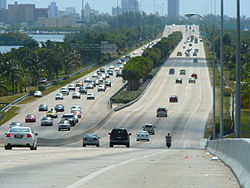Interstate 195 (Florida)
 From Wikipedia - Reading time: 13 min
From Wikipedia - Reading time: 13 min
| Julia Tuttle Causeway | ||||
| Route information | ||||
| Auxiliary route of I-95 | ||||
| Maintained by FDOT | ||||
| Length | 4.42 mi[1] (7.11 km) | |||
| Existed | December 23, 1961[citation needed]–present | |||
| NHS | Entire route | |||
| Major junctions | ||||
| West end | ||||
| East end | ||||
| Location | ||||
| Country | United States | |||
| State | Florida | |||
| Counties | Miami-Dade | |||
| Highway system | ||||
| ||||
Julia Tuttle Causeway | |
|---|---|
 The Julia Tuttle Causeway eastbound connecting Midtown Miami with Miami Beach | |
| Carries | 6 lanes of I-195 |
| Crosses | Biscayne Bay |
| Locale | Miami |
| Characteristics | |
| Design | Beam, fill causeway |
| Material | Slabs and girders |
| Total length | 2.5 miles (4.0 km) |
| Longest span | 0.4 miles (0.64 km) |
| Clearance above | 68 feet (21 m) |
Interstate 195 (I-195) is a 4.42-mile-long (7.11 km) auxiliary Interstate Highway connecting I-95, its parent route, in the west with Miami Beach in the east. It crosses Biscayne Bay by traveling over the Julia Tuttle Causeway. The causeway is named after Miami founder Julia Tuttle.
It is part of the longer State Road 112 (SR 112), which continues to the west as the Airport Expressway and to the east as Arthur Godfrey Road (41st Street).
As part of a pilot program, the Florida Department of Transportation painted the shoulders as bike lanes east of US Highway 1 (US 1). Pedestrians are still prohibited.
Route description
[edit]

I-195 begins at the eastern end of the I-95 and SR 112 interchange, also known as the 36th Street Interchange, heading east with interchanges with Miami Avenue and US 1 before heading onto the Julia Tuttle Causeway, where the Interstate crosses Biscayne Bay. At the eastern end of the causeway in Miami Beach, it has an interchange with SR 907 before terminating at the intersection of SR 907A and Arthur Godfrey Road, about a mile (1.6 km) west of SR A1A.[2][3]
History
[edit]On December 23, 1961, three signed roads along the route of SR 112 were opened: the 36th Street Tollway, now the Airport Expressway, I-195, and the I-195 Spur along with a stretch of I-95 in Miami. The I-195 Spur was the surface portion of the west–east state road along Arthur Godfrey Road in Miami Beach, connecting I-195 and SR A1A east of the causeway. The I-195 Spur signs disappeared from the road shortly after the designation was decommissioned by the newly formed U.S. Department of Transportation in the late 1960s.[citation needed]
In popular culture
[edit]Famously, in early 1975, the rhythm of their car on this road was the inspiration for the Bee Gees's song "Jive Talkin'".[4]
Exit list
[edit]The entire route is in Miami-Dade County.
| Location | mi[5] | km | Exit | Destinations | Notes |
|---|---|---|---|---|---|
| Miami | 0.000 | 0.000 | – | SR 112 continues west | |
| 0.000 | 0.000 | 1 | Westbound exit and eastbound entrance; I-95 exit 4 | ||
| 0.678 | 1.091 | 2A | North Miami Avenue | Eastbound exit and westbound entrance | |
| 1.051 | 1.691 | 2B | |||
| Biscayne Bay (Intracoastal Waterway) | 1.651[6]– 3.690 | 2.657– 5.938 | Julia Tuttle Causeway | ||
| Miami Beach | 4.27[6] | 6.87 | 5 | Eastbound exit and westbound entrance | |
| 4.424 | 7.120 | – | At-grade intersection; SR 112 continues east | ||
1.000 mi = 1.609 km; 1.000 km = 0.621 mi
| |||||
See also
[edit]- Jive Talkin' (Bee Gees song - Origins)
- Julia Tuttle Causeway sex offender colony
References
[edit]- ^ Starks, Edward (January 27, 2022). "Table 2: Auxiliary Routes of the Dwight D. Eisenhower National System of Interstate and Defense Highways". FHWA Route Log and Finder List. Federal Highway Administration. Retrieved January 1, 2023.
- ^ Map of Interstate 195 (Map). MapQuest, Inc. 2009. Archived from the original on September 11, 2013. Retrieved July 22, 2012.
- ^ "Interstate 195 (Florida)" (Map). Google Maps. Retrieved July 22, 2012.
- ^ "The Bee Gees – 35 Years of Music". Billboard. Vol. 113, no. 12. March 24, 2001. p. 22. ISSN 0006-2510.
- ^ "Florida Department of Transportation Interchange Report" (PDF). Florida Department of Transportation. August 4, 2010. pp. 8–10. Archived from the original (PDF) on February 8, 2012. Retrieved November 2, 2010.
- ^ a b FDOT straight line diagrams Archived March 6, 2014, at the Wayback Machine, accessed March 2014
External links
[edit] Media related to Interstate 195 (Florida) at Wikimedia Commons
Media related to Interstate 195 (Florida) at Wikimedia Commons- FDOT GIS data
- Florida @ SouthEastRoads - Interstate 195 and Florida 112
 KSF
KSF
